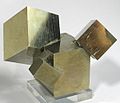Crystal habit
Under crystal habit means the relative size ratio of the individual faces of a crystal to each other and the resulting form. In contrast, the crystal costume is understood to mean the entirety of the crystal surfaces developed on a crystal.
There are three basic types of habitus:
- With an isometric habit, the ratio of diameter to length is roughly the same. Isometrically developed crystals can be found mainly among the minerals with a cubic crystal system such as Boleit , diamond , halite , garnet , magnetite , pyrite and tetrahedrite .
- Crystals with a prismatic to needle-like habit are one-dimensional elongated forms in which the length of the crystal is significantly greater than its diameter. Well-known minerals with prismatic crystal growth include autunite , the aragonite variety iron blossom , mesolite , millerite ( hair pebbles ), quartz , rutile (often needle-like grown into quartz), stibnite ( antimonite ) and tourmalines .
- One speaks of a planar or even tabular habitus in the case of two-dimensional forms, if z. B. the diameter of the crystal is much larger than its length. Mostly tabular crystals are found among the minerals of the mica group such as biotite and muscovite , but also with autunite , barite , torbernite , vanadinite and wulfenite .
A variety of terms are used, however, such as thick tabular, leafy, short columnar, obtuse columnar, granular, cubic, radial fibrous, stalky, rhombohedral and many more.
prismatic, columnar smoky quartz
literature
- Rudolf Graubner: Lexicon of geology, minerals and rocks . Emil Vollmer Verlag, Munich 1980, ISBN 3-87876-327-1 , p. 203 .
- Hans Jürgen Rösler : Textbook of Mineralogy . 4th revised and expanded edition. German publishing house for basic industry (VEB), Leipzig 1987, ISBN 3-342-00288-3 , p. 86 .
Web links
- Mineral Atlas: Habitus (Wiki)
- khulsey.com - Crystal Habit - Crystal Growth ( January 19, 2011 memento in the Internet Archive )
- galleries.com - Descriptive Crystal Habits





